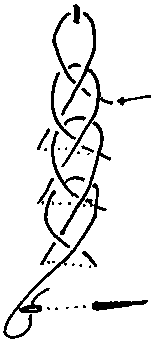

This document is provided as is without any express or implied warranties. While every effort has been taken to ensure the accuracy of the information contained, the author assumes no responsibility for errors or omissions, or for damages resulting from the use of the information contained herein.
Permission is granted to make and distribute verbatim copies of this document for non-commercial private research purposes provided the copyright notice and this permission notice are preserved on all copies.
This document was originally published in the 1995 Arts and Sciences Supplement of Pikestaff, the newsletter of the East Kingdom, Society for Creative Anachronism, Inc. It has been updated to reflect both some more current information and some conventions of the web.
Copyright © 1993, 1994, 1997 Carolyn Priest-Dorman.
Excellence in leather tailoring and other works of the needle dates back to the Stone Age in Scandinavia. However, the adoption of textile weaving techniques in Scandinavia only occurred in the Bronze Age, relatively late in the scheme of human development (Bender Jørgensen, 116). Nevertheless, as is evident in the remains from Migration and Viking Age burials, the art caught hold rapidly and took many elaborate forms.
Possibly because of the late onset of textile weaving in Scandinavia, the tradition of decorative textile embroidery seems also to have been established late. Judging from what remains of Scandinavian textiles, at the beginning of the Viking Age only faltering steps had been taken toward decorative textile embroidery. The tjald (hanging) and refil (a figured frieze like the Bayeux Tapestry) of the Viking Age were composed not of embroidery but of wool-on-linen tapestry weaves accented by soumak (Grenander-Nyberg, 122). The same is true for household furnishings such as pillowcases, cushion covers, and tablecloths; all the evidence points to a strong tradition of decorative polychrome mixed-fiber weaving rather than one of needle-worked surface ornamentation.
Embroidery as we in the SCA understand it wasn't really adopted by the Vikings until the first half of the ninth century. At that point the pervasive influence of the foreign cultures with which the Vikings intermingled so freely began to assert itself in both technological and art-historical ways. In textile and clothing ornamentation, the Vikings began half-heartedly to imitate their neighbors at that time. Two distinctive embroidery styles emerged, a style influenced by the lands to the west (represented mostly by finds at Bjerringhøj and Jorvík) and a style influenced by the lands to the east (represented by finds at Birka and Valsgärde).
The western-influenced style might have been learned from the Anglo-Saxons. It was most often composed of fiber-on-fiber stitchery and involved stitches that are known in the modern world, such as stemstitch, couching, chain stitch, and raised herringbone stitch. One of the earliest finds of such embroidery from a clearly Viking context is on the gowns of the two women in the Oseberg ship burial in Norway, which has been recently and securely dated to 834 (Bonde and Christensen, 581). Unfortunately, the information available so far on the textiles from this find is scanty and tantalizingly vague in many respects. It is therefore hard to classify the embroidery as "eastern" or "western" in influence, but judging from what little else we know--that there was silk appliqué and embroidery on the queen's gown and some sort of freehand fiber-to-textile embroidery in the form of animal masks on the servant's (Ingstad, 96)--it seems to fit the "western" model more completely than the eastern.
Also in the ninth century, the eastern-influenced style of embroidery was on the rise. This style, represented at Birka in Sweden, was more likely Kievan Rus, Byzantine, or Slavic in origin. Like other forms of eastern Viking ornament, it depended heavily on silver wire or thread for its decorative effect. In fact, eastern Viking embroidery (more properly, "textile surface decoration") involved only one or two techniques which are likely to have been worked with a needle, i.e., stemstitch, surface couching, and possibly some forms of ösenstich (mesh stitch), of which several varieties have been identified. However, properly understood, ösenstich is not primarily a needle technique, even though it makes use of the same topology as some common embroidery stitches. It is much simpler to work with the wire by itself instead of going to the trouble of threading it through a needle first (Jensen, passim). Briefly described, ösenstich requires using a wire approximating a 26-gauge beading wire to work rows of closely-spaced mesh stitch into strips of tubing, flattened metallic trimming, or three-dimensional shapes such as teardrops. The finished wire constructions were sometimes sewn to garments as ornaments. The most common of the ösenstich variants was worked somewhat like a Vandyke stitch; see below for a redrawing or the diagrams in Geijer (p. 110) for more information.

But from the perspective of an SCA embroiderer, Viking embroidery did not really catch on until the tenth century, the period of the find from Bjerringhøj (Mammen parish, Denmark), the same find that yielded up the "Mammen axe." The late tenth-century man's grave there yielded a quantity of the kind of finds we would be most likely to consider "true" embroidery: the remains of two wool 2/1 twill textiles, possibly from a cloak or other garment(s), with several different motifs embroidered in stem stitch. The cloth fragments are dark brown now, but they may once have been brightly coloured; similarly, the two shades of brown wool floss may originally have been two completely different colours. Some of the remaining motifs are executed in outline form only; however, the scrolling leaf motif is outlined in threads of the light shade and filled in selectively with the darker shade. Munksgaard notes that there is evidence that the base cloth is "tightly covered with needle holes," indicating the previous presence of some other embroidery, now decayed. Based on the survival in the grave of both wool and silk textiles, she concludes that the cloth was additionally embroidered with linen thread (166), which is especially prone to decay in burials.
At least three of the Viking period graves at Valsgärde in Sweden yielded examples of spun silver-thread metallic embroidery, possibly influenced by Byzantine fashion. Information on some of the Valsgärde graves was recently published for the first time, in sketchy but informative detail, by Lise Bender Jørgensen. Several different pieces of silver-thread embroidery on silk have been found in Graves 10, 12, and 15. Three were surface couched--two onto silk tabby weave grounds and one onto silk twill (samite)--and some are simply reported as "embroidered," all worked on samite. All the embroidered pieces appear to be garment trimmings. All three graves date to the tenth century (Bender Jørgensen, 263f), which coincides with the suggested dating for some fragmentary gold-thread embroideries from the western Viking culture (Ingstad, 144f). One of the finds from Grave 15 is pictured in Graham-Campbell (Plate 356a, page 276). The "World of the Vikings" CD-ROM also illustrates this piece extensively (Reference numbers 2363, 2365, 2367, 2369, 2371, 2373, 2375, and 2377). It is hard to determine the exact technique used in the piece, but the photos seem to indicate that it is composed of closely packed stem-stitching, or possibly some sort of couching. Bender Jørgensen does report the presence of couching work on some of the Valsgärde pieces, but the description of the piece that is pictured in Graham-Campbell does not mention couching. That piece is considered to be a "collar." The other illustrated pieces are called "cuffs" in the "World of the Vikings"; although in a different motif from the "collar," they appear to have been executed in the same stitch (Reference numbers 2379, 2381, 2383, and 2385).
Known examples of stem stitch occur in five graves from Birka (Sweden), belonging to both men and women; all date to the tenth century (Geijer, 108f). Materials used include wool floss on wool fabric, silk floss on silk fabric, and gold thread on an unknown and now-decayed background. One instance was of silk floss used to apply a decorative silk samite strip over a linen ground on a man's garment (Geijer, 170); one was of decorative wool stemstitching used to strengthen two layers of wool in some sort of garment edging (Geijer, 109). The stitching seems to have been planned to economize on thread; stitches on the wrong side of the fabric are short, and those on the right side of the fabric are long, especially when gold thread is being used (Geijer, 108).
Only one example of embroidery on textile has appeared in the Danelaw, from the Viking period at Jorvík (York, England). It was found on a small, clumsy bag dating to the late tenth or early eleventh century. The outer cover of the bag is red silk samite imported from Byzantium; it is decorated with a crude silk cross in what appears to be chain stitch (Walton, 369). The bag may have been a reliquary.
One additional type of embroidery that seems to have been practiced even before the Viking Age was the ornamentation of seams. This practice occurred in an earlier related context, on a seam from a seventh-century pillow cover from the Sutton Hoo textiles (Crowfoot, 422), possibly indicating a tradition of some antiquity in north Europe. In the ninth century, one of the Oseberg garment seams is oversewn in some sort of loop stitch with a thread used double (Ingstad, 92). In similar fashion, some of the ninth- and tenth-century Hedeby and Birka finds display corded or braided thread appliqué over the seams (Hägg 1984, 169). The tenth-century Mammen grave contained a wool cushion with embroidery over a seam (Hald, 282). The stitches used on the Sutton Hoo and Mammen finds are similar: both yield a thick, wide strip with a plaited appearance. But whereas the stitch used on the Sutton Hoo pillow was a complex interlaced variant of Vandyke stitch (see the figure on the left below, redrawn from Crowfoot), the stitch used on the Mammen cushion was simpler, a closely-worked variant of herringbone (see the figure on the right below, redrawn from Hald).

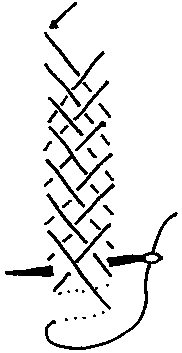
The little that can be gathered from the information on the Valsgärde embroideries suggests that one of their design motifs was perhaps Byzantine in inspiration. See below for a redrawing of the stylized vegetation motif shown in the photo in Graham-Campbell. This is the "collar" piece. The original embroidery is about 4 centimeters wide, on a strip of silk 6 centimeters wide.
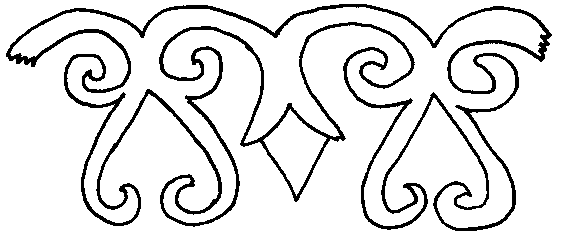
The other motif, for the "cuffs," is smaller. It is a sort of interlace motif in the Borre style ("World of the Vikings" CD- ROM, Reference Number 2379).
Most of the instances of stem stitch at Birka do not employ an identifiable, separate embroidery motif. They seem largely to be used for such decorative construction techniques as appliqué and the strengthening of edges. Still, since gold threads were occasionally found independent of any background fabric it is virtually impossible to determine what their original disposition was. One identifiable motif, a continuously stepped line, is reproduced below. The embroidery came from Grave 735 (mid-tenth century) and probably decorated a man's silk samite belt.

Not much information is available about the design of the Oseberg embroideries. Munksgaard refers in passing to "the beautiful silk embroideries at Oseberg, with various animals, with heads turned back, placed in circles reminiscent of the Borre style" (167). Ingstad (1992, 179) includes a line drawing of a fragment in this style. The two pictured beasts are very stylized and could represent either deer, lions, or perhaps horses. They are executed in what seems to be several colors, and the backgrounds inside the rondels are filled with stitches also. Another illustrated motif (180) is confused but appears to be a cross, which raises interesting questions. The Oseberg textiles are due to be published one day soon, at which time it will be more obvious where they fit into the history of Viking needlework.
At least six different motifs appear on different scraps of the Mammen embroidered textiles, only some of which appear visibly Viking in influence. See below for sketches of five of the motifs.
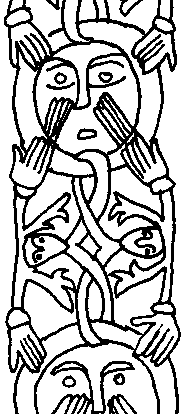

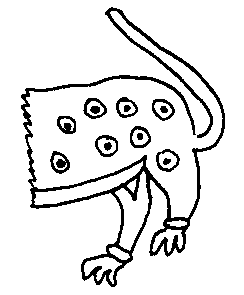

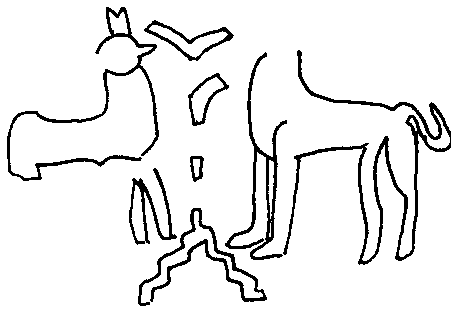
The sixth is fragmentary but believed to represent a bird. For good drawings, see Roesdahl (page 127), from which this redrawing was made; for photos of the originals, much less easy to intepret, see Hald (107-110). The most characteristically Viking of the lot is a running strip of stylized round human faces placed vertically; each face is executed in outline form, about three inches across, and they are interlaced with small hands and looping bits of what looks like vinework. A second human mask motif is less carefully constructed; its faces are more oval and there is no interlacing. This interpretation of the human face, except for its lack of moustache, is similar in style to the faces depicted on the Bamberg and Cammen caskets (Munksgaard 169), which can be viewed in Plates LIV and LVIa in Wilson and Klindt-Jensen. The third motif is the rear half of a spotted male quadruped with legs and feet that are purely and exuberantly Viking in character.
Two other motisf from the Mammen textile are much more derivative in their designs. The first, a twining vine about three-quarters of an inch wide with continuous S-curves, shares an affinity with both Byzantine and Anglo-Saxon acanthus motifs. It looks surprisingly "medieval," as opposed to "Viking," and is quite similar to some of the standard foliage design elements of the high feudal period. The second motif is a pair of quadrupeds facing one another with a narrow vertical element, possibly a Tree of Life, in between them. Such motifs are known from eastern silk textiles of the period. This last embroidery is rigidly designed in comparison to the lively lines of the other motifs; it may have been adapted more or less wholesale from a foreign textile motif.
One should never rely on re-drawings when photos of the originals are available. For good photos of the extant finds, and for more information generally, please check out the books listed in the bibliography.
Contains detailed information on several thousand textile finds encompassing every major north European culture outside Scandinavia. There is also some information on Scandinavian finds, although most of them were covered in the author's Forhistoriske Textiler i Scandinavien (1986, with an extensive English summary). Details of spinning and weaving in the catalogue are balanced by several chapters reconstructing the details of particular times and places. The "Conclusions" chapter, offering a history of textile industry and trade focusing on the Roman and post-Roman period, ought to be required reading for anyone interested in early period textiles.Bonde, Niels, and Arne Emil Christensen. 1993. "Dendrochronological dating of the Viking Age Ship Burials at Oseberg, Gokstad and Tune, Norway." Antiquity, 67, no. 256 (September 1993), pp. 575-83.
Dating based on tree-ring analysis of the wood found in these burials against established tree-ring chronologies for Scandinavia.Geijer, Agnes. 1938. Die Textilfunde aus den Gräbern. Birka: Undersuchungen und Studien III. Uppsala: Kungl. Vitterhets Historie och Antikvitets Akadamien.
The book that paved the way for Viking textile research, this book has terrific plates and line drawings of the various embroidery-related arts found at Birka.Graham-Campbell, James. 1980. Viking Artefacts: A Select Catalogue. London: British Museum Publications, Ltd.
One of the two best books on Viking material culture, it is a catalogue of the famous 1980 museum exhibit. Includes citations to original write-ups as well as photos of some otherwise completely obscure finds like the Valsgärde embroidery.Graham-Campbell, James, and Kidd, Dafydd. 1980. The Vikings. London: Tabard Press and The Trustees of the British Museum.
A good color photo of the Lund "embroidery," which is actually appliqué work and not embroidery at all. Still, it's a good example of a Viking-style trimming technique.Grenander-Nyberg, Gertrud. 1992. "Soumak Technique in Swedish Medieval Textiles." Archaeological Textiles in Northern Europe: Report from the 4th NESAT Symposium 1.-5. May 1990 in Copenhagen, ed. Lise Bender Jørgensen and Elisabeth Munksgaard, pp. 117-127. Tidens Tand 5. Copenhagen: Det Konglige Danske Kunstakademi.
Analysis of soumak tapestries of the Viking and High Middle Ages periods; includes brief discussion of the Oseberg tapestry. Report on a reproduction of one tapestry being woven on a warp-weighted loom at a Swedish museum.Hägg, Inga. 1986. "Die Tracht." Chapter 8 of Systematische Analysen der Gräberfunde, ed. Greta Arwidsson. Birka: Untersuchungen und Studien, vol. 2, no. 2, pp. 51-72.
A chapter presenting the results of the modern re-examination of the Birka garment textiles; it also contextualizes much of the bare information presented in Geijer, 1938. I am indebted to Christina Krupp (Mistress Marieke van de Dal) for my understanding of this chapter.Hägg, Inga. 1984. Die Textilfunde aus dem Hafen on Haithabu. Berichte über die Ausgrabunge in Haithabu, 20. Neumünster: Karl Wachholtz Verlag.
Analysis of several textiles found re-used as caulking of tenth- century ships in Hedeby harbor. I am indebted to Christina Krupp (Mistress Marieke van de Dal) for my understanding of this source.Hald, Margrethe. 1980. Ancient Danish Textiles from Bogs and Burials, trans. Jean Olsen. Copenhagen: The National Museum of Denmark.
Some discussion of the Bjerringhøj embroideries--motifs, techniques, and materials. Some nice plates, too, if you can get ahold of the book and not a photocopy.Ingstad, Anne Stine. 1982. "The Functional Textiles from the Oseberg Ship." Textilsymposium Neumünster: Archaeolögische Textilfunde, 6.5 - 8.5.1981., ed. Lise Bender Jørgensen and Klaus Tidow, pp. 85- 96. Neumünster: Textilmuseum Neumünster.
What little there is in English on these Oseberg textiles; hard to find and harder to understand, but it's much better than nothing at all.-----. 1992. "Textilene i Osebergskipet," pp. 176- 208Oseberg-Dronningens Grav: Vår arkeologiske nasjonalskatt i nytt lys, ed. Arne Emil Christensen, Anne Stine Ingstad, and Bjørn Myhre. Oslo: Schibsted.
Although it's in Norwegian, this chapter is useful because it has the only known published likeness of the Oseberg embroidery. It's only a line drawing of a couple of the fragments, but hey, that's something.Jensen, Jørn V. 1990. Vikingesmykker: Elegante Smykker i Kobber- og Solvtråd med Vikingeteknik og enkelt Væktøj. Haarlev, Denmark: Privately published.
Parts of the English section of this work were brought to my attention by Barbara Bishop (Lady [now Countess] Brigit of Mercia). It is impossible to reconstruct the original pamphlet from the pieces I have seen, but it is possible to learn the ösenstich technique from it. I believe it is marketed at the museum at Lejre, Denmark.Munksgaard, Elisabeth. 1984. "The Embroideries from Bjerringhøj, Mammen." Festskrift til Thorleif Sjøvold på 70-årsdagen, ed. Mari Høgestøl et al. Universitetets Oldsaksamlings Skrifter Ny rekke 5. Oslo: Universitetets Oldsaksamling.
The most in-depth examination of the embroideries and textile grounds of this tenth-century find, including art-historical analysis and parallels to contemporary art in other media. Some guesses about which garment(s) might have been embroidered.Roesdahl, Else. 1982. Viking Age Denmark, trans. Susan Margeson and Kirsten Williams. London: British Museum Publications, Ltd.
A good general history book that also happens to have good reproductions of the line drawings made at the time the Bjerringhøj embroideries were excavated. For getting an unimpeded look at the pure designs, check this book first.Roesdahl, Else, and Wilson, David M., eds. 1992. From Viking to Crusader: The Scandinavians and Europe 800-1200. New York: Rizzoli International Publications, Inc.
A catalogue of the 1992-1993 Viking exhibition that toured Europe. Although the "reconstruction" of the Bjerringhøj garments on page 193 is questionable in some ways, including the reconstructors' choice of embroidery locations, at least you can get some idea of how the embroidery might have looked if it were executed in as many different colors as this reconstruction posits.Walton, Penelope. 1989. Textiles, Cordage and Fiber from 16-22 Coppergate. The Archaeology of York 17:5. Dorchester: The Council for British Archaeology and The Dorset Press.
Excellent analysis of archaeological textile finds from York during its Viking period (ninth through eleventh centuries).Wilson, David, and Ole Klindt-Jensen. Viking Art, second edition. The Nordic Series, 6. Minneapolis: University of Minnesota Press, 1980.
A detailed examination of the periods and styles of Viking art, taking into account the most common media for its expression. Many valuable black and white plates.
This page was created on 30 June 1996 and last updated on 27 March 1997.
Search this site | To Þóra's Viking resources page | To Þóra's textile resources page
No soliciting! | capriest@cs.vassar.edu